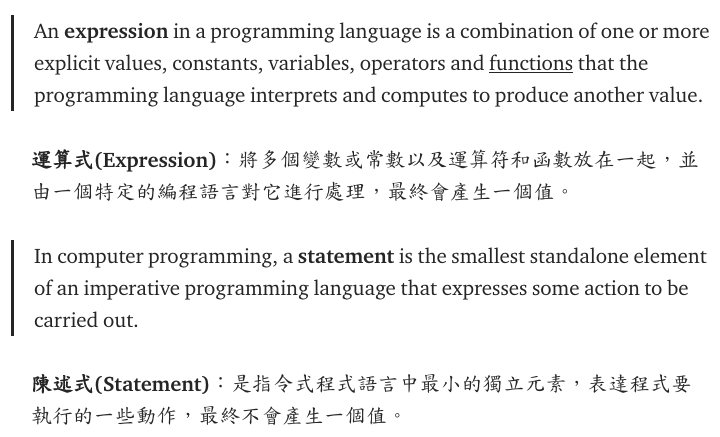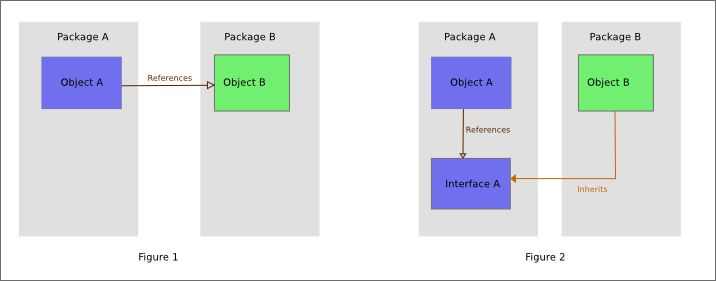Software Development Tips
以套件實現系統功能的優先順序考量
- 系統套件
- 第三方開源套件
- 自己修改過的第三方套件
- 自己刻的套件
Semantic Versioning 語意化版本
- Semantic Versioning: MAJOR.MINOR.PATCH
- MAJOR: when making incompatible changes.
- MINOR: when adding functionality in a backward compatible manner.
- PATCH: when making backward compatible bug fixes.
License
Naming
- flatcase
- camelCase, lowerCamelCase, dromedaryCase
- StudlyCase, UpperCamelCase, CapitalCamelCase, BumpyCase, PascalCase
- kebab-case, dash-case, hyphen-case, param-case, caterpillar-case, spinal-case, brochette-case, css-case, lisp-case
- Train-Case
- COBOL-CASE
- snake_case, pothole_case, c_case
- MACRO_CASE, ALL_CAPS, UPPER_CASE, SCREAMING_SNAKE_CASE
Expression v.s. Statement

- expression: any section of codes evaluating to a value.
- statement: a complete line of code performing some actions, without a value returned.
Object-Oriented Programming
- High cohesion, low coupling.
- Not Encapsulation, Inheritance or Polymorphism, but Abstraction to deal with complexity easily.
- Write Everything Twice -> Don't Repeat Yourself.
- SOLID by Robert. C. Martin for OOP clean code design
- Single responsibility principle(單一功能原則): A software entity(module, class, function) should have one, and only one, reason to be changed.
- Responsibility is a "reason to change".
- Open-closed principle(開閉原則): A software entity should be opened for extension, but closed for modification.
- When a new feature needs to be built inside it, extend the entity instead of modifying it.
- Liskov substitution principle(里氏替換原則): Derived classes must be substitutable for their base classes.
- a.k.a. Behavioral Subtyping.
- The signature, return type and exception types of a method must be same in base class and its derived classes.
- Interface-segregation principle(介面隔離原則): Many client-specific interfaces are better than one general-purpose interface.
- Role Interface: make fine grained interfaces that are client-specific.
- Dependency inversion principle(依賴反轉原則): Use Dependency Injection to decouple software modules.
- High-level modules shouldn't depend on low-level modules. Both should depend on abstractions.
- Depend on abstractions, not on concretions.
- Abstractions shouldn't depend on details. Details should depend on abstractions.
- High-level modules shouldn't depend on low-level modules. Both should depend on abstractions.
- Single responsibility principle(單一功能原則): A software entity(module, class, function) should have one, and only one, reason to be changed.

Architectures
"The only way to go fast, is to go well." — Robert C. Martin
- The Clean Architecture
- Hexagonal(六角形) Architecture: Ports(interfaces) & Adapters(implementations)
- Android Modularization: Hexagonal Architecture with Kotlin and MVVM
- Pros: Testability & Maintainability, because of more modularity.
- Cons: Complexity, because of more time-costing built artifacts when the application is bigger.
- Screaming Architecture
- The Onion Architecture
- Separation of concerns: The application codes are separated into layers.
- Entities: Enterprise Business Rules, business objects of the application.
- Use Cases: Application Business Rules
- Ports & Interactors
- Orchestrate the data flow to and from the Entities, and direct them to use their enterprise wide business rules to achieve the goals of the use case.
- Interface Adapters: Controllers, Presenters & Gateway
- Convert data from the format which is most convenient for the use cases and entities, to the format which is most convenient for some external agencies.
- ex. MVC architecture of a GUI.
- Frameworks & Drivers: External Interfaces, UI, Web Framework or API, Devices & DB
- Dependency rules
- Dependency points inward, each layer only interacts with the layers inside it.
- Concrete modules depend on the more abstract ones.
- More bottom/inner, more generic/abstract
- Implementation details(mechanisms) -> policies & rules.
- Separation of concerns: The application codes are separated into layers.
Unit Testing
- A small piece of code that applies input to a component under testing and then asserts expectations.
- What are properties of good Unit Testing?
- run fast: for big scale input and fast feedback loop while coding.
- small and focus: test only one piece of logic every time without any control flow or iteration in it.
- isolated: states when each test ends should be same as their beginning.
- trustworthy: developers in your team need to trust the test.
- readable and maintainable: follow coding style.
- automated: use frameworks in IDE or CI.
- 2 types
- State-based: result-driven, black-box, ex. JUnit
- input -> component under testing -> output
- Interaction-based: action-driven, white-box, ex. Mockito
- State-based: result-driven, black-box, ex. JUnit
- 3A rule
- Arrange: 設置環境 -> Given
- Act: 動手做實驗 -> When
- Assert: 驗證 -> Then
- Test Naming:
methodOrClassUnderTest_actionOrInput_expectedResult
Test Doubles 測試替身
- 搞笑談軟工:什麼是測試替身?
- A version of a class crafted specifically for testing, replacing its real version in tests.
- Fake: a "working"(producing realistic outputs when given inputs) implementation of the class to make it good for testing but unsuitable for production.
- Mock: tracks which of its methods were called, then the test passed or failed depends on whether these methods were called correctly.
- Spy: tracks some additional information of its methods, such as the number of calling a method.
- Stub: includes no logic and only returns what you program it to return.
- Dummy: passes around but not used, such as if you just need to provide it as a parameter.
- To avoid flaky(易碎成小薄片的) tests: test cases with inconsistent results when run repeatedly on the same test code.
Test Driven Development
- Write tests first, write enough feature code to pass the tests, and refactor the feature code better and able to pass them as well.
- To protect your feature code from ever accidentally reintroducing bugs of the feature in the future.